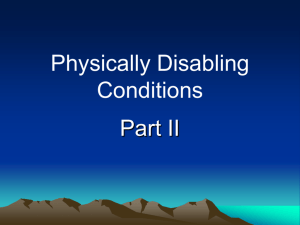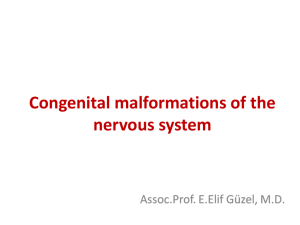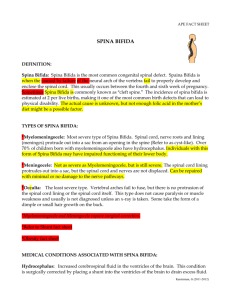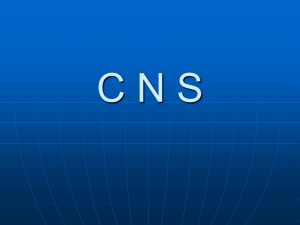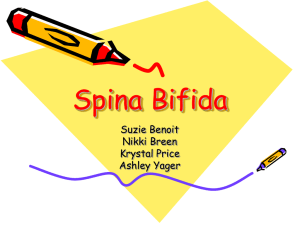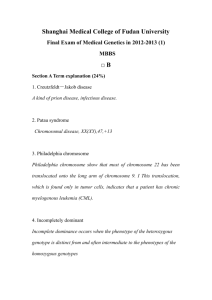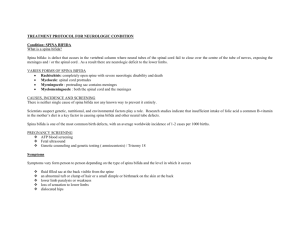Spina Bifida
advertisement
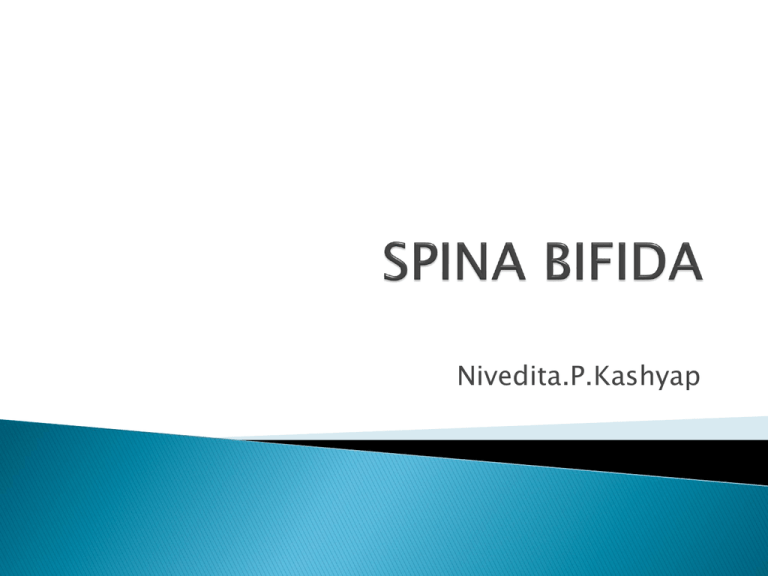
Nivedita.P.Kashyap Spina Bifida is a latin word for split spine. Most common group of birth defects called neural tube defects (NTD). The neural tube develops into the brain and spinal cord. Definition : It is a congenital abnormality with developmental defect in the spinal column with incomplete closure of vertebral canal due to failure in fusion of vertebral arches ± protrusion and dysplasia of the spinal cord or its membranes. Spina Bifida is a spinal defect usually diagnosed at birth by the presence of an external sac on the infants back.ti tube birth defect resulting from the incomplete closure of the embryonic neural tube the abnormal portion of the spinal cord sticks out through the opening in the bones vertebrae overlying the open portion of the spinal cord remains unfused and open It’s a defect of the spine in a developing fetus, it affects the brain,spinal cord,and it’s muscles surrounding it, and resulting in loss of movement and or sensation to the legs and feet as well as bowel movement and bladder dysfunction. When does Spina Bifida occur? Occurs between days 24 and 28 of gestation. This disorder arises from abnormalities occuring during three major concurrent migrations of cell groups during embryogenesis which include those of the neural tube, the notochord, and the mesenchymal tissue. The notochord is a column of cells that run up the length of the embryo between the ectoderm and endoderm. It plays an important role in inducing formation of the spinal cord and spinal column. The neural tube is the precursor of the brain and spinal cord. At this stage the ectodermal cells in the midline differentiate into neuroectoderm to form the neural plate. The neural plate elevates to form neural folds that then meet or close at midline to form the neural tube. Normal embryological development Neural plate development -18th day Cranial closure 24th day (upper spine) Caudal closure 26th day (lower spine) Neural Tube defects may result from: Combination of environmental and genetic causes Teratogens Nutritional deficiencies - notably, folic acid deficiency Women with certain chronic health problems such as diabetes and seizure disorders have an increased risk of having a baby with spina bifida especially if taking anticonvulscent medications. 1- Closed : Occulta = hidden 2- Opened: Cystica = Manifesta Forms of spina bifida Occulta Meningocele Myelomeningocele Occulta : • • • • Mildest form of spina bifida The outer part of some of the vertebrae are not completely closed gap in one or more of the vertebre of the spine The split in the vertebrae is so small that the spinal cord does not protrude The condition is asymptomatic Bony abnormality seen by X – ray Nerves may be involved when associated with hairy patch or other skin changes dimple, hairy patch, dark spot or swelling over affected area the spine dimple, hairy patch, dark spot or swelling over affected area spinal cords and nerves usually normal no treatment needed Cystica: 1- Meningeocele: Rarest form a cyst consisting of membranes surrounding the spinal cord pokes through the open part of the spine. Can be removed surgically allowing for normal development. sac contains membranes that protect spinal cord, but not spinal nerves Myelomeningeocele: Sac contains neural elements that protrude through the spinal defects The overlying skin is thin & leaks of spinal fluid Secondary infection is common , Neurological and Orthopaedic problem are present. Hydrocephalus(arnold- chiari malformation) Clinical Picture: It will differ according to the level of lesion (most common site is lumbosacral region) Flaccid paralysis, muscle weakness, wasting, decreased or absent tendon reflexes Decreased or absent extroceptive & proprioceptive sensation Rectal & bladder incontinence, Hydrocephalus, Sever vasomotor changes Paralytic or congenital deformities as in club foot , pes cavus. Pressure ulceration due to poor sensation, Osteoporosis , soft tissue contracture Physical emotion& mental delay Prognosis: With successful closure of simple meningeocele prognosis is good Myelomeningeocele die from infection, if survive after proper closure ---------- stationary disability Lipomeningocele (lipo = fat) lipoma or fatty tumor located over the lumbosacral spine. Associated with bowel & bladder dysfunction • - couples who already had an affected baby have an increased risk of having another affected baby • - women who are obese, have poorly controlled diabetes, or who are treated with certain anti-seizure meds have a higher risk • - more common in Hispanics and Caucasions • Folic Acid -- 70% NTDs can be prevented • multivitamin of 400 micrograms of folic acid every day • every day foods: grain products, fortified foods, leafy-green vegetables, dried beans, oranges, orange juice Amniocentesis AFP - indication of abnormal leakage Blood test Maternal blood samples of AFP Ultrasonography For locating back lesion vs. cranial signs Physiological changes below the level of the lesion generally include: abnormal nerve conduction, resulting in: somatosensory losses motor paralysis, including loss of bowel and bladder control Anatomical changes below the level of lesion: musculoskeletal deformities (scoliosis) joint and extremity deformities (joint contractures, club foot, hip subluxations, diminished growth of non-weight bearing limbs) osteoporosis abnormal or damaged nerve tissue Anatomical changes associated with a cervical lesion: An enlarged head caused by hydrocephalus One way that Spina Bifida is being treated is by operating on the fetus while still in the womb. This procedure is done as if fetus is being delivered via cesarean section. Another way is that it is usually treated surgically between 24 to48 hours after birth. Impairments associated with spina bifida: Physiological changes occur below level of lesion : Abnormal NCV Lead to changes in muscle tone Anatomical changes below level of lesion: Musculoskeletal deformities(Scoliosis), osteoporosis Joint&extermity deformities, damaged nerve tissue Diminished growth of non Wt bearing joints Complication & team work: 1- Mass& Hydrocephalus…………….Neurosuergon 2- Movement disorders, Deformity……………PT 3- Bowel& Bladder Disturbance…………..Urologist 4- Social& Psychological problem………………Psychiatrist& Social worker PT EXAMINATION: 1. Inspection: Tuft of hair, subcutaneous lipoma ordimple may be observed in occulta Localised sac in cystic type, increased head size, Deformity of Lower limb as flexion: Abd & int rotation of hip, flexion or hyper extension knee, equinous or calcenous deformity of foot, scoliosis or lordosis of spine Skin ulceration and soft tissue injury due to pressure 2. Palpation: Bony defect, subcutaneous lipoma, Loss of sensation and muscle bulk 3. Measurement: a- Tape measurement : Head L.L (long& round) b- Geniometer test ROM 4. Muscle Testing 5. Functional Test (UP & Low Limb) 1- Upper Limb Exercises: Children with spina bifida needs to compansate weakness in their legs and trunk : Strong arms assist for ADL such as: Helping in sitting without trunk stability Using hand-operated mobility aids: wheel chair, crutches Periodically rise from chair to relive pressure symptoms on skin Transferring from seat to toilet, Standing up from chair Extending the arms to lift the seat off the floor Press- up with pillows under the knees and feet 2- Poor Sitting balance: Children with spina bifida with sever high level have a poor sitting balance due to : Lack of dynamic stability(weak trunk muscles) Weak trunk muscles, Paralysed leg to counterbalance movement of upper limb Lack of sensation from buttocks , lower limb( no proprioception, feedback on base of balance from Lower limb) Large head (hydrocephalus) How to overcome Poor Sitting balance: Head control Exercises Strengthening exercises of back muscles and balance Exercises (Rolling, getting from prone to sit) Special seats to provide adequate support Regular relive the pressure is necessary P.T Modalities: Extensive PT program should be applied in cases of partial paralysis Electrotherapy to relive pain and induce relaxation Passive movement and passive stretching to maintain available ROM prevent soft tissue contracture Active exercises to prevent muscle imbalance Hyderotherapy when skin is intact to improve ROM Gait training by using Braces Bladder management: Renal disease is responsible for all cases of death in spina bifida, So bladder care is vital for spina bifida children Aims: 1- prevent infection 2- establish a satisfactory method of emptying of bladder A Patient with spina bifida may have one of the following: 1- Automatic Bladder: is found in children with cyst above T10-11 pressing on cord lead to hyper reflexia of all muscle below level of injury. The muscle will contract in response to certain degree f filling that lead to open the sphincter Empty the bladder should be performed every one hour and the baby will remain dry. 2- Autonomous bladder(non- reflex): Most common in spina bifida patient Atonic bladder, No reflex action, used suprapubic manual pressure to empty bladder every hour should be carried out by parents to keep the child dry until be mature enough to do it by himself. Bowel management: Bowel training performed when the patient is on full diet Mild aperient in the evening Glycerin suppository in the morning followed 15 minutes later by digital evacuation Correct diet and fluids Evacuation should be conducted by patrents till child be mature enough Sensation: Children will lack sense of pain temperature touch pressure. They cannot protect themselves from hot water and burn. They have insensitive feet Care should be taken to Ankle foot orthosis from pressure Proprioception: Lack of proprioceptive feedback from muscles lead to lack of tactile kinetic feed back They rely on visual input only to develop sense of body awareness difficulty in maintain balance and upright sitting Orthosis: Ankle Foot Orthosis with or without external aids used when lower lumber level of lesion, power 5 of quadriceps , 4 of medial hamstring muscles early walking is better than wheel chair in children with high level of lesion in spina bifida Two orthosis are used to maintain reciprocal gait pattern and enabling standing Reciprocating gait orthosis and hip guidance orthosis Prerequisites of fitting orthosis: 1- No more than 20 degree of hip flexion 2- knee and foot can be rendered in plant grade position
